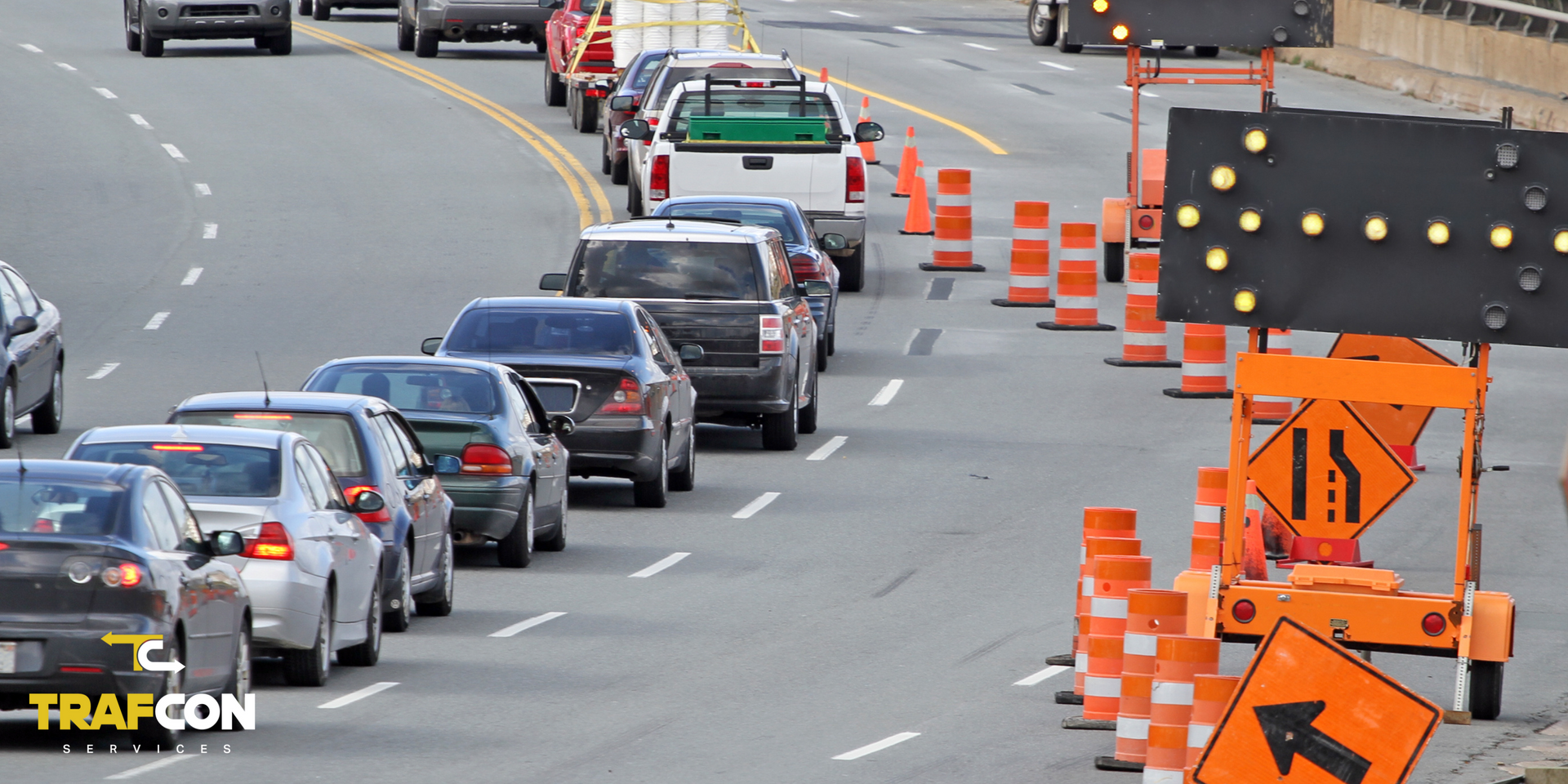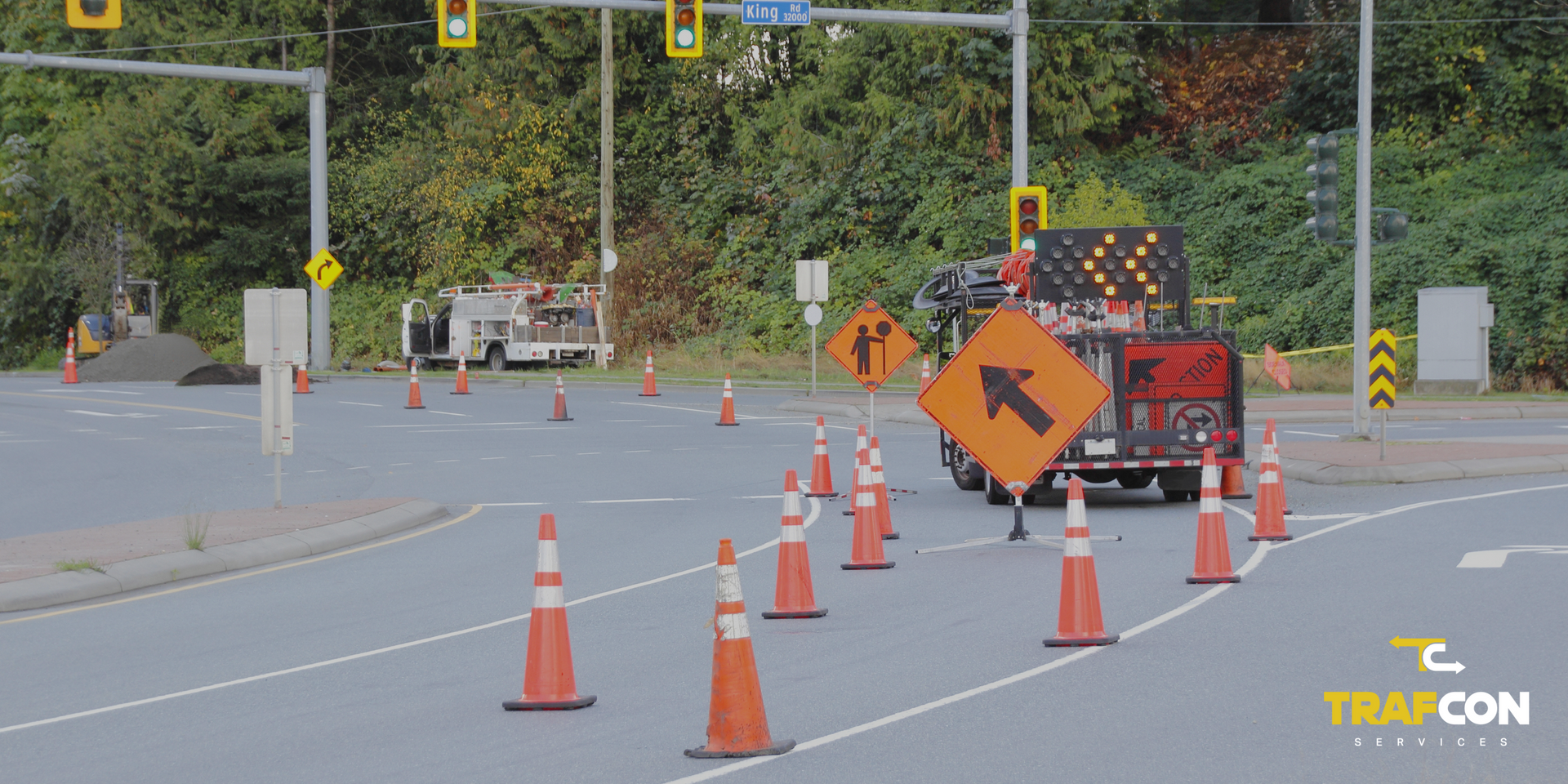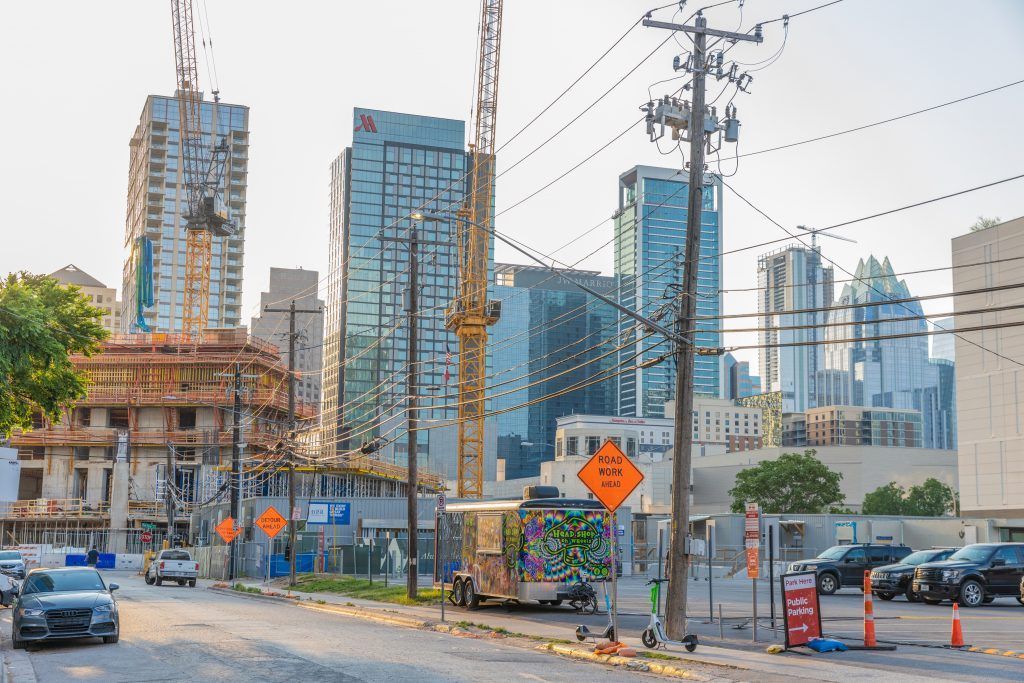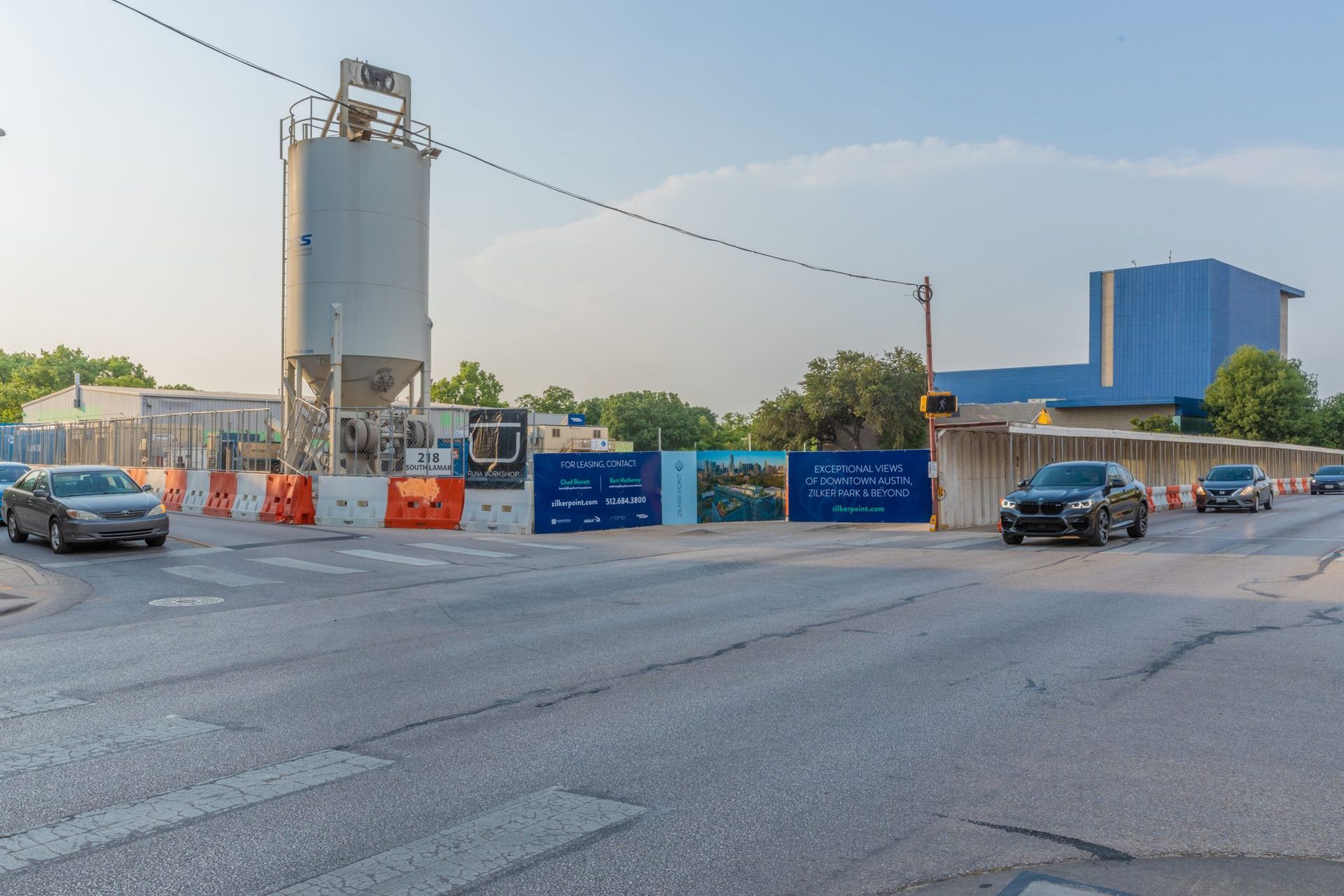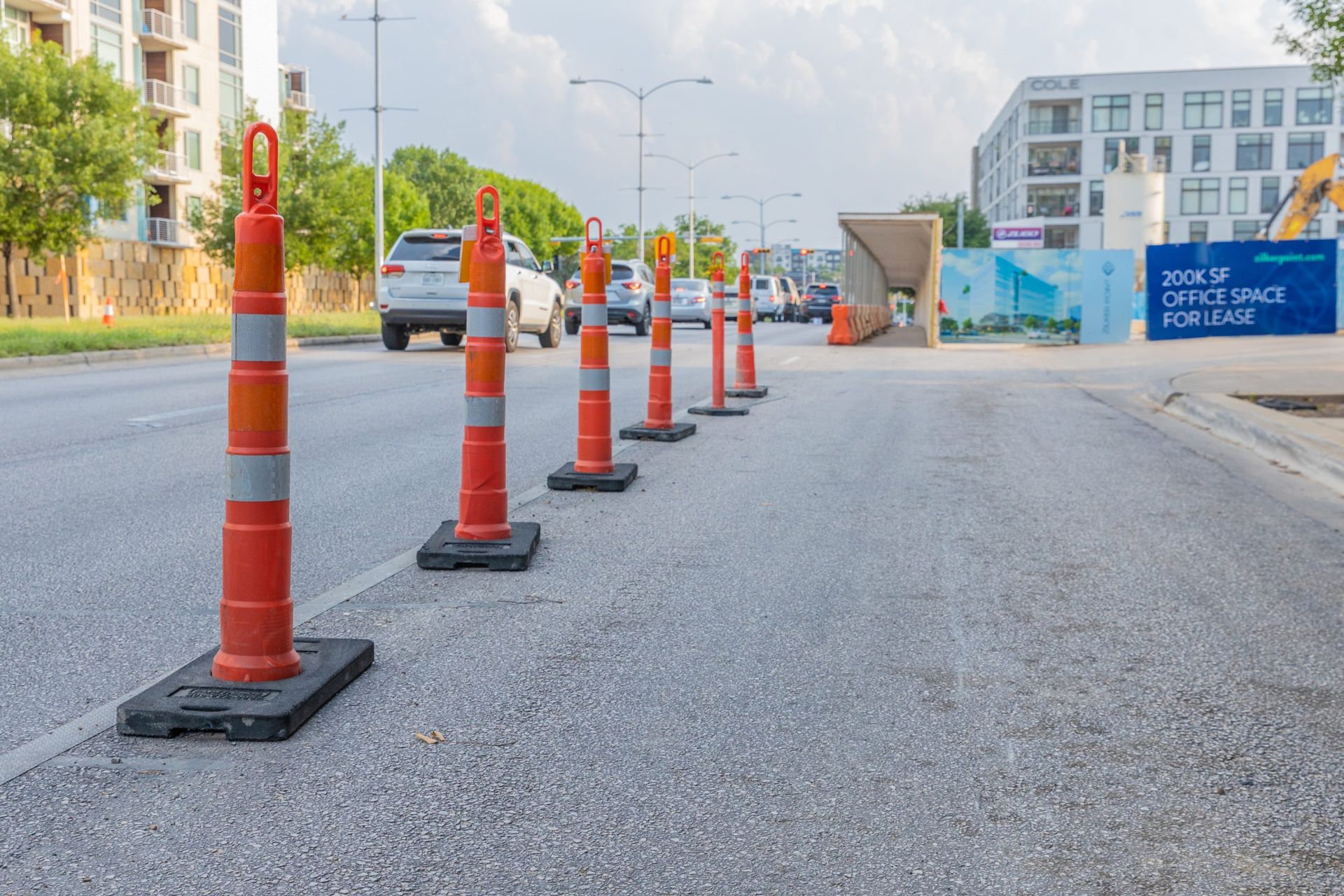Essential Elements of an Effective Traffic Control Plan in Austin, Texas


Essential Elements of an Effective Traffic Control Plan in Austin TX
A traffic control plan ensures safe traffic flow around construction sites by identifying hazards and setting strategies to manage them. This guide will cover the essential elements and importance of a traffic control plan.
Key Takeaways
- Traffic control plans are essential for managing traffic flow and ensuring safety at construction sites, consisting of clear signage, barriers, and detour routes.
- Key components of effective traffic control include advanced signage, proper barriers, and well-planned detour routes to minimize disruptions and enhance safety.
- Professional traffic control services provide expertise in legal compliance, equipment, and project management, leading to cost savings and improved safety during construction.
Understanding Traffic Control Plans
Detailed guides known as traffic control plans are essential for the management of traffic around construction zones, with an emphasis on maintaining both safety and efficiency. Their key role is to pinpoint potential dangers and devise methods to lessen their impact, thereby forging a safer space for workers as well as those who use the roads.
Through careful planning and execution, these plans significantly reduce interruptions in traffic flow while bolstering the effectiveness of traffic control measures.
Key Components of a Traffic Control Plan
An effective traffic control plan comprises several crucial elements aimed at directing and safeguarding both drivers and workers. This includes the implementation of unmistakable signage and signals, suitable barriers, as well as clearly marked detour paths to direct traffic around lane closures. Every one of these components contributes significantly to maintaining a steady flow of traffic while reducing any interruptions.
It is necessary to delve deeper into each fundamental aspect that constitutes this system.
Signage and Signals
Signage and signals play a critical role in the management of traffic control. Devices used for this purpose, which include advanced warning signs, markings on the pavement, and lights designed to caution drivers, are essential for conveying important information to those behind the wheel. This allows them to be aware of alterations in road conditions and assists their safe navigation through areas undergoing construction.
Take downtown Austin as an example. There’s been effective use of a lane shift alongside distinct signage that has proficiently directed motorists around zones under construction while maintaining both safety measures for all parties involved and uninterrupted traffic flow.
Barriers and Channelizing Devices
Channelizing devices and barriers play a crucial role in creating secure areas for workers within zones of construction by demarcating them clearly. Concrete blocks, plastic cones, and flexible barriers are among the traffic control measures that not only direct the flow of traffic but also safeguard those on-site. Ensuring these devices are strategically positioned and highly visible is essential to boost driver alertness and minimize accident occurrences.
To maintain their function and longevity, it’s vital to carry out consistent inspections as well as upkeep. These procedures confirm that traffic control elements remain effective in managing roadways efficiently.
Detour Routes and Alternate Paths
Effective traffic management is crucial for preserving the flow of traffic during construction projects. This requires a meticulous approach, which includes examining alternate pathways, scrutinizing prevailing traffic trends and evaluating roadway states. For maximum driver clarity and safety while reducing uncertainty, detour signs should be positioned thoughtfully.
Enhancing the overall efficacy of managing traffic hinges on creating detour routes that are well-conceived to keep disruptions to a minimum.
Types of Traffic Control Measures
To effectively manage traffic in the vicinity of construction sites, an array of traffic control strategies are utilized. These strategies encompass the implementation of lane closures, road closures, and mobile operations that are custom-designed to align with the unique requirements of each project. The meticulous planning and execution of these measures aim to minimize traffic disruptions, diminish inconvenience for motorists, and augment safety.
A comprehensive analysis is provided below regarding these distinct measures for traffic control.
Lane Closures
To manage traffic during road work and sustain the flow of vehicles, lane closures are routinely implemented. These restrictions on lane usage may come in various forms such as a single-lane closure, double or even multiple lane closures tailored to meet the specific demands of each project. The I-710 rehabilitation initiative employed weekend-only lane closures to reduce interference with regular traffic patterns.
An effective system of signage coupled with traffic control signals is indispensable for alerting drivers about which lanes are accessible and securing adherence to these adjustments.
Road Closures
Partial or complete road closures have a notable impact on travel routes. Completely shutting down the facility during full closure removes any contact with work zones, as traffic is rerouted to ensure continued movement in adjacent regions.
During such closures, it’s crucial to implement temporary barriers and pedestrian detours for pedestrians in order to safeguard both workers and individuals using the road. Efficiently overseeing these road closures can result in financial benefits and heightened safety measures.
Mobile Operations
Mobile operations, characterized by work that progresses in a non-stationary manner, necessitate specialized traffic control devices. This frequently includes vehicles outfitted with lighting to augment their visibility and function as mobile signs.
These types of operations demand unique measures for controlling traffic due to their transient nature. Such measures are crucial to safeguard the well-being of workers and motorists alike.
Traffic Control Devices
Traffic control devices are essential components of a traffic control plan, used to guide drivers through work zones and around lane closures. These devices include:
- Cones: Cones are versatile and widely used in traffic control. They help divert traffic, indicate lane closures, and provide a clear visual warning to drivers. Their bright colors and reflective strips make them highly visible, even in low-light conditions.
- Signage: Signage is crucial for providing information to drivers about lane closures, detours, and other traffic control measures. Clear and well-placed signs ensure that drivers are aware of upcoming changes and can navigate safely through work zones.
- Pavement Markings: Pavement markings guide drivers through work zones and around lane closures. These markings, which include lines, arrows, and symbols, help maintain orderly traffic flow and reduce confusion.
- Warning Lights: Warning lights are used to alert drivers to potential hazards and provide a clear visual warning. These lights are especially important in low-visibility conditions, such as nighttime or inclement weather, ensuring that drivers can see and respond to changes in the road ahead.
- Detour Signs: Detour signs direct drivers around lane closures and road closures. By providing clear and concise directions, these signs help minimize disruptions and maintain traffic flow.
- Temporary Barriers: Temporary barriers prevent vehicles from entering closed lanes or roads. These barriers, which can be made of concrete, plastic, or other materials, provide a physical barrier that enhances safety for both workers and drivers.
By incorporating these traffic control devices into a single lane closure traffic control plan, construction projects can effectively manage traffic flow and ensure the safety of all road users.
Road Closure Types
There are several types of road closures, each with its own unique characteristics and requirements. Understanding these types is crucial for developing an effective traffic control plan.
- Full Road Closure: A full road closure involves the complete closure of a road or highway. This type of closure is often used for major construction projects or emergency situations where it is necessary to completely restrict access to ensure safety. During a full road closure, traffic is typically rerouted to alternate routes to maintain flow.
- Partial Road Closure: A partial road closure involves closing one side of a road or highway. This type of closure is commonly used for reconstruction projects where work is being done on one side of the road while the other side remains open to traffic. Proper signage and barriers are essential to guide drivers safely through the area.
- Lane Closure: A lane closure involves closing one or more lanes of a road or highway. This type of closure is frequently used for maintenance or construction projects that require work to be done in specific lanes. Effective lane closure traffic plans include clear signage and signals to inform drivers of the changes and ensure safe navigation.
- Shoulder Closure: A shoulder closure involves closing the shoulder of a road or highway. This type of closure is often used for maintenance or construction projects that do not require the closure of traffic lanes. A well-designed shoulder closure traffic control plan ensures that drivers are aware of the closure and can adjust their driving accordingly.
By understanding and implementing the appropriate type of road closure, construction projects can minimize disruptions and maintain safety for all road users.
Developing a Traffic Control Plan for Construction Projects
Formulating a proficient plan for traffic control within construction projects requires essential actions such as evaluating the needs of the project, planning out the flow of traffic, and collaborating with municipal officials. Employing techniques such as phasing of construction activities and implementing complete road closures can markedly diminish disruptions in traffic flow and bolster safety measures.
Below is an expanded analysis of these procedures.
Assessing Project Requirements
Evaluating the unique needs of a project, including considerations such as the configuration of roadways and the volume of traffic flow, is crucial for formulating a bespoke plan for traffic control. This process involves taking into account various elements like existing traffic dynamics and prospective risks.
By following regulatory standards set forth by entities such as MUTCD, adherence to legal requirements is ensured while simultaneously improving safety measures.
Designing the Traffic Flow
Effective traffic control requires the formulation of detailed plans that meticulously mirror the current conditions and allocations of street lanes. To handle traffic during significant events at Zilker Park, specific measures such as established detour pathways and extra staff are utilized to oversee the flow.
In order to preserve access for inhabitants and guests while executing improvements on Barton Springs Road, strategies were implemented with an aim to minimize lane closures throughout the project’s duration.
Coordination with Local Authorities
Working closely with local officials is crucial in securing the required permits and adhering to established rules. This partnership facilitates an efficient traffic control system that conforms to community-specific standards.
The specialized knowledge of handling processes like the City of Austin’s Right of Way Management Approval Network (ROWMAN) proves extremely beneficial.
Traffic Control Plans for Specific Road Types
Traffic control plans must be tailored to the specific road type and traffic conditions to ensure effectiveness and safety. Different road types require different traffic control measures.
- High-Speed Roads: High-speed roads, such as highways and expressways, require more advanced traffic control measures. These may include dynamic message signs that provide real-time information to drivers and variable speed limits to manage traffic flow. Temporary barriers and warning lights are also essential to enhance safety in these high-speed environments.
- Low-Speed Roads: Low-speed roads, such as residential streets, may require more basic traffic control measures. Cones and signage are often sufficient to guide drivers and ensure safety. However, it is still important to consider the specific conditions of the road and adjust the traffic control plan accordingly.
- Urban Roads: Urban roads require consideration of pedestrian and cyclist traffic, as well as public transportation. Traffic control plans for urban areas should include measures to protect pedestrians and cyclists, such as dedicated detour paths and clear signage. Coordination with public transportation authorities is also crucial to minimize disruptions to bus and train services.
- Rural Roads: Rural roads may require more advanced traffic control measures due to their unique characteristics. Warning lights and temporary barriers can enhance safety in these areas, especially where visibility is limited. Traffic control plans for rural roads should also consider the potential for higher speeds and less frequent traffic.
By tailoring traffic control plans to the specific road type and conditions, construction projects can effectively manage traffic and ensure the safety of all road users.
Special Considerations for Work Zones
It is essential to prioritize special measures in work zones to safeguard the well-being of workers and those utilizing the road. This entails establishing suitable barriers and signage to reduce potential dangers, scheduling operations with peak traffic periods in mind for fewer disturbances, and maintaining open communication channels with the public.
By working jointly with local emergency responders, swift access can be facilitated during emergencies, which boosts safety in these areas.
Special Conditions
There are several special conditions that must be considered when developing a traffic control plan. These conditions can significantly impact the effectiveness and safety of the plan.
- Weather Conditions: Weather conditions, such as rain, snow, or extreme heat, can affect visibility and road conditions. Traffic control plans should include measures to address these conditions, such as additional signage, warning lights, and temporary barriers to enhance safety.
- Nighttime Work: Nighttime work requires additional lighting and warning devices to ensure visibility and safety. Traffic control plans for nighttime work should include adequate lighting to illuminate the work zone and clear signage to guide drivers.
- Pedestrian and Cyclist Traffic: Pedestrian and cyclist safety is a critical consideration in traffic control plans. Measures such as dedicated detour paths, clear signage, and barriers can help protect pedestrians and cyclists and ensure their safe passage through or around work zones.
- Public Transportation: Public transportation, including buses and trains, must be considered in traffic control plans. Coordination with public transportation authorities is essential to minimize disruptions and ensure the continued operation of services.
- Emergency Situations: Emergency situations, such as accidents or natural disasters, require quick and effective traffic control measures. Traffic control plans should include provisions for emergency access and coordination with emergency responders to ensure swift and safe responses.
By considering these special conditions, traffic control plans can be more effective and adaptable, ensuring safety and minimizing disruptions.
Case Studies of Successful Traffic Control Plans in Austin
Studies of past cases have demonstrated the effectiveness of well-implemented traffic control plans. In Austin, joint efforts from various parties involved have achieved efficient regulation of lane closures and maintenance of steady traffic flow amidst construction activities. These approaches have enhanced safety measures and minimized disturbances in regular traffic patterns.
By examining specific instances, we can see this in action.
Downtown Austin Roadwork
In the midst of construction within downtown Austin, traffic control strategies are critical for maintaining a smooth flow of vehicles and safeguarding pedestrians. Utilizing temporary barriers, appropriate signage, and strategically devised detour paths as part of comprehensive traffic control plans has proven to be instrumental in diminishing interruptions. Such measures have been greatly effective in curtailing congestion while bolstering the safety of both workers on site and members of the community.
Events at Zilker Park
During events at Zilker Park, specific measures are taken to ensure steady traffic flow and attendee safety. This includes the use of specialized traffic control tactics such as assigning detour routes and deploying extra staff for effective management of the traffic.
Barton Springs Road Improvements
The improvement project on Barton Springs Road is designed to boost traffic management, prioritize safety, and improve the overall flow of vehicles. The strategy involves installing clear signage and barriers for safe vehicle guidance alongside alternate routes that help limit delays and mitigate confusion. To lessen inconvenience, lane closures will occur intermittently during periods when there is less traffic.
Benefits of Professional Traffic Control Design
Employing expert traffic management services brings several advantages. These professionals possess the necessary high-grade equipment and an in-depth understanding of area-specific laws, guaranteeing adherence to legal standards and improving overall safety.
By delegating the responsibility for traffic control to specialists, project leaders can concentrate on additional essential duties, thereby achieving savings over time as well as diminishing potential legal responsibilities. When experienced personnel oversee efficient traffic organization during projects, optimal outcomes are secured.
Traffic Control Plan Evaluation
A traffic control plan must be evaluated regularly to ensure its effectiveness and safety. This ongoing evaluation process includes several key steps:
- Monitoring Traffic Flow and Congestion: Regular monitoring of traffic flow and congestion helps identify any issues or bottlenecks. This information is crucial for making adjustments to the traffic control plan to improve efficiency and reduce delays.
- Evaluating the Effectiveness of Traffic Control Devices: Assessing the performance of traffic control devices, such as signage, cones, and barriers, ensures they are functioning as intended. Any issues with visibility, placement, or effectiveness should be addressed promptly.
- Assessing the Safety of the Work Zone: Regular safety assessments of the work zone help identify potential hazards and ensure that safety measures are in place and effective. This includes checking the condition and placement of barriers, signage, and other safety devices.
- Identifying Areas for Improvement: Continuous evaluation helps identify areas where the traffic control plan can be improved. This may include adjusting the placement of traffic control devices, updating signage, or implementing additional safety measures.
- Making Adjustments to the Traffic Control Plan as Needed: Based on the evaluation findings, necessary adjustments should be made to the traffic control plan. This ensures that the plan remains effective and responsive to changing conditions and requirements.
By regularly evaluating and updating traffic control plans, construction projects can maintain high levels of safety and efficiency, ensuring smooth traffic flow and minimizing disruptions.
By following this structured approach, the new sections will seamlessly integrate into the existing article, providing comprehensive and detailed information on essential elements of an effective traffic control plan.
Why Choose TrafCon Services for Your Traffic Control Needs
As a leading firm in Austin, Texas for traffic control design and consulting, TrafCon Services distinguishes itself with an ATSSA certification that reflects their commitment to the utmost standards of traffic safety.
Their expertise extends to various services such as designing plans for controlling traffic, providing professional consultancy, assisting with obtaining necessary permits, and offering logistical support during special events. By working closely alongside event organizers and municipal staff members, they guarantee not only smooth operation throughout each project, but also uphold stringent safety measures.
Schedule a FREE Site Walk Today
Elevate your traffic control strategies by arranging a complimentary site walkthrough with TrafCon Services. Dial (512) 994-7830 now to schedule your free assessment, tailored to pinpoint your unique traffic management requirements and guarantee the seamless progression of your projects.
Summary
To summarize, the implementation of robust traffic control measures is crucial for regulating traffic near construction zones to promote safety and maintain efficiency. Essential elements such as signage, barriers, and alternative detour paths are vital in reducing interruptions. Employing professional agencies like TrafCon Services can result in considerable advantages such as reduced expenses and improved safety levels. It is advisable not to delay scheduling a complimentary site inspection to commence advancements in your traffic control strategies.
Frequently Asked Questions
What are traffic control plans?
To prioritize the safety and efficiency of both workers and motorists, traffic control plans are vital documents that manage the flow of traffic around construction areas. These plans are imperative in reducing interruptions to traffic while boosting road safety.
Why are detour routes important in traffic control?
Detour routes are crucial in traffic control as they ensure a smooth traffic flow and reduce disruptions during road construction by offering alternative paths for drivers.
This approach enhances safety and efficiency on the roads.
How do barriers and channelizing devices enhance safety?
Barriers and channelizing devices enhance safety by clearly delineating safe zones in construction areas, which protect workers and effectively guides traffic.
This structured approach minimizes the risk of accidents and ensures a safer environment for everyone involved.
What benefits do professional traffic control services offer?
Expert services in traffic control not only deliver top-notch equipment and guarantee adherence to legal standards, but also promote cost-effectiveness by adeptly directing traffic throughout various projects.
The proficiency of these services significantly boosts the safety and productivity for individuals working on-site as well as for drivers passing through.
Why choose TrafCon Services for traffic control needs?
Choosing TrafCon Services for your traffic control needs ensures you receive ATSSA certified, comprehensive solutions backed by extensive local experience in the Austin market.
Their expertise will help enhance safety and efficiency for your projects.
SHARING IS CARING
New Paragraph

